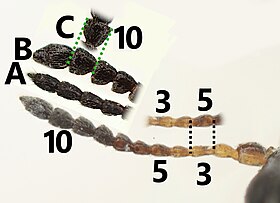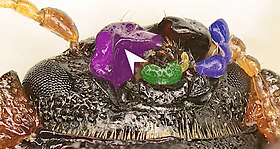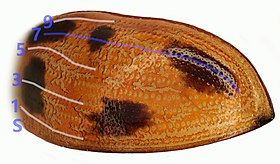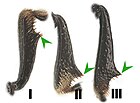Osier leaf beetle
| Osier leaf beetle | ||||||||||||
|---|---|---|---|---|---|---|---|---|---|---|---|---|

Gonioctena viminalis on willow leaf with traces of feeding |
||||||||||||
| Systematics | ||||||||||||
|
||||||||||||
| Scientific name | ||||||||||||
| Gonioctena viminalis | ||||||||||||
| ( Linnaeus , 1758) |
The osier leaf beetle ( Gonioctena viminalis , also known as changeable willow leaf beetle ) is a beetle from the leaf beetle family . The genus Gonioctena is represented in Europe with six subgenera and twenty-one species , the species Gonioctena viminalis belongs to the subgenus Gonioctena and occurs in Europe in the subspecies Gonioctena viminalis viminalis .
The beetle, which is also at home in German-speaking countries and is easy to observe, usually lays eggs, but occasionally also gives birth to fully developed larvae. The larvae like to have skin contact with each other, produce antibodies and are initially looked after by the mother.
Notes on the name
The beetle is already described in the famous 10th edition of Linnés Systema Naturae from 1758 and bears the name Chrysomela viminalis there .
As the species name for his Chrysomela, Linné mainly chooses the names of plants on which the beetles can be found. Even before the introduction of the binomial nomenclature Linnaeus describes in the first edition of the fauna Svecica ( wildlife of Sweden ) in 1746 the Beetle as Chrysomela with # 429. And names as its host plant in the pasture with shaggy leaves ( lat. Habitat in Salice foliis hirsutis with reference to pasture No. 811 in the Flora Svecica ( flora of Sweden )). In the expanded edition of Fauna Svecica from 1761, the beetle already bears the number 524 and the name Chrysomela viminalis and the Sal willow is named as the host plant ( lat.habitat in Salice caprea, also with reference to willow no.811 in Flora Svecica ). In the first description in 1758, Linnaeus noted that the host plant was more general on willows (lat. Habitat in Salicibus ). He gives the name Chrysomela caprea to the brown-yellow willow leaf beetle with the number 64. Salix viminalis is the name of the wicker willow on which the beetle can also be found. The vernacular name osier leaf beetle corresponds to this .
The beetle was temporarily placed as Phytodecta viminalis or as Phytodecta (Gonioctena) viminalis in the genus Phytodecta .
The genus Gonioctena was established by Motschulski in 1869 . The generic name Gonioctena is derived from the ancient Greek γονία, 'gonía' for 'corner' and κτείς, κτενός 'ktēīs, ktenós' for 'comb' and refers to the tooth-like middle and rear rails that are extended to a corner . On the side facing the tarsi, these are covered with teeth like a comb (Fig. 6).
Properties of the beetle
The beetle reaches a body length of 5.5 to seven millimeters. The bottom and the head are black. The pronotum and elytra are red with black spots that vary widely in size and number. Kraatz already names over 20 variants, Löbl lists 29 named variants for the subspecies Gonictena viminalis viminalis alone . The beetle can also be completely black. It has the oval and arched shape typical of leaf beetles, but the pronotum is relatively flat.
The head closes tightly to the pronotum. It is carried lowered by more than 45 degrees to the longitudinal axis of the body. The antennae are eleven-link and string-shaped, the last links are flattened with widened end links (in Fig. 2 for comparison A from the side, B in top view). The base links are usually yellowish, the terminal links dark. The third antenna element is hardly longer than the fifth (length comparison in Fig. 2 by black, dashed auxiliary lines), the tenth is no longer than wide (comparison of length and width in Fig. 2 B and C with green auxiliary lines). The upper jaws are hollowed out laterally (cavity in Fig. 3 tinted intensely pink) so that the end links of the jaw buttons (in Fig. 3 tinted blue) can be inserted into them. The upper jaw also shows recesses on the underside, in which the lip probes (tinted yellow in Fig. 3) come to rest (arrowhead in Fig. 3).
The flat pronotum has a transverse spot in front of the tag , which is often divided into two spots. The pronotum is roughly punctured on the side, the puncture becomes fine to very fine in the middle (Fig. 4). The front corners of the pronotum are strongly rounded, the rear corners close to the elytra at approximately right angles.
The label is black, not yellow or a lighter shade of brown.
The points of the elytra are arranged in nine rows that show only a few irregularities. In particular, the seventh row of dots in the posterior elytra is not irregular due to dots placed next to it (Fig. 5). A shortened scutellar stripe is formed between the wing cover suture (suture) and the 1st point stripe. The intervals between the rows of dots are finely and irregularly dotted. The elytra are shiny. There are up to five spots on each wing cover, but on the one hand their number can be reduced to zero, on the other hand they can become large and merge with one another. In extreme cases, the wing covers can be completely black on top. The epipleures of the wing covers are hidden (underside in Fig. 1).
The legs are completely black, at most partially reddish on the rails. As with all species of the genus, the middle and rear rails in front of the tarsi are drawn out into a triangular tooth (Fig. 6 II and III). The back of this tooth is covered with small teeth like a comb. In Gonioctena viminalis and in some other species of the genus, the anterior splint at the tip is also extended like a tooth outside and reinforced there with teeth (Fig. 6 I). The apparently four tarsal links (a fifth link is tiny) are wide, the claws are toothed (Fig. 7).
larva
The larvae (Fig. 8) are up to ten millimeters long in the last stage with a width of about three millimeters and a head width of 1.7 to 1.8 millimeters. The top is slightly arched and the bottom is fairly flat. The colored larvae are dark brown-black on top, the underside is paler. The color is due to the fact that the pale reddish-yellowish skin is quite densely covered by heavily sclerotized plates that form black-brown tubercles . Newly hatched larvae are orange-red (Fig. 11).
The head is glossy black. The head shield is clearly set off. The antennae are short and tripartite. The upper lip is deeply cut out, the upper jaw has five teeth. The jaw probes are tripartite, the first one much wider than it is long, the second a little narrower and about the same length as it is wide, the third cone-shaped. The lip probes are two-part, conically pointed, the base part is much thicker than the end part. On each side there are six individual eyes, one below the antennae, the second a little further away behind the antennae, the other four further back and above in the form of a square.
The front breast is a little more shiny than the following segments and has a delicate longitudinal line. When viewed from above, the middle and rear chest hardly differ from the six anterior abdominal segments. All are divided by a transverse incision into two very similar transverse bulges when viewed from above. Also with regard to the width, the chest sections imperceptibly merge into the abdomen sections. The body widens up to the sixth abdominal segment, after which it gradually narrows. Between the seventh and eighth abdominal segments there are paired evertable glands (Fig. 10). The chaetotaxy indicated at Hee-Wook Cho.
A description of the doll (Fig. 12) including the identification key can be found in Steinhausen.
biology
 
|
|
| Fig. 8: Larva from the front and the side | |
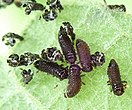 
|
|
| Fig. 9: on the left younger larvae with exuvia from the previous larval stage, on the right older larvae |
|

|

|
| Fig. 10: Defense glands everted |
Fig. 11: Moult, exuvia still on the abdomen |
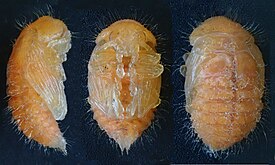
|
|
| Fig. 12: Doll from the side, below and above | |
The beetles can be found from May to July on damp forest edges or in sparse areas in the forest with willows , also on the banks of waters, in moors, quarry landscapes and on salt marshes . Beetles and larvae feed on the leaves of various types of willow, but the beetles can also be found near the host trees on hazel or under stones. Host plants in Central Europe are in particular ear willow , sal willow , gray willow and basket willow . The beetle was also found on the large-leaved willow on the Feldberg . The beetles eat holes in the leaves from the edge (taxo picture), the larvae skeletonize the leaves.
The life cycle is one year. The insect overwinters as a beetle and appears on the host plants in April. If disturbed, the animals can fall on the floor. A maturation feeding is not necessary. The beetles mate several times in May. The larvae develop in the eggs in the womb, so that they can hatch immediately after they have been laid ( ovoviviparia ). However, cases are also described in the literature in which the larvae leave the egg in the womb and are deposited by the beetle as finished larvae without egg shells. In the first case, the entire egg supply (up to fifty pieces) is deposited in small heaps on the underside of the leaves at once. The eggs are reddish, cylindrical and slightly pointed at the ends. The larvae hatch immediately after oviposition. In the second case, up to forty larvae are born in quick succession. These are initially yellow-orange, but quickly darken and eventually turn black. At least during the first two larval stages, the larvae stay close together and feed together (Fig. 9). When a leaf is eaten, the larvae socialize again on another leaf. Obviously there is already a sense of community here. During the early stages of development, the larvae are also protected by the mother. The beetle hangs near the larvae, leaving eggs unprotected.
The molt to the next stage is also carried out at the same time. Pupation takes place at the end of June, beginning of July after the fourth larval stage in the ground. The beetle hatches about twelve days later. The total development from oviposition or birth to the beetle hatching takes about 33 days. In a series of experiments in the laboratory, the larvae were kept in groups of different sizes with plenty of food. It was found that in groups with few larvae, food consumption and weight gain per larva decreased. In extreme cases, larvae kept in isolation showed behavioral disorders and died. The negative effect on development when experimentally preventing the common way of life decreases significantly in the third and fourth larval stage.
If it is more annoyed, the larva bends the abdomen upwards in an abrupt movement and for a short time turns out a red, paired gland about one millimeter long between the seventh and eighth abdominal rings (Fig. 10). Fresh-smelling droplets with antibodies sit on this. At the same time, a light red membrane is turned out in a ring around the anus. The antibodies consist of more than ninety percent of an identified ketone and four other chemical compounds.
After mating and laying eggs, the beetles can still be found on the leaves, from the end of June the beetles of two generations can be present at the same time. Despite the short development time, no second generation is trained. However, the beetles disappear relatively early. In the process, the animals from the previous year die, the newly hatched generation crawls into the ground for a summer dormancy (dry air causes lethargy in the beetle), which turns into winter dormancy. Animals were observed that did not eat any food for eleven months until the next spring, although it was available.
In mass infestation, Gonioctena viminalis can become harmful in osier crops.
distribution
The subspecies Gonioctena viminalis viminalis is widespread in Northern and Central Europe. In Europe, it is only missing in the south ( Albania , Greece , Spain , Portugal and some countries bordering the Adriatic ). To the east, the subspecies is represented as far as Siberia. The subspecies Gonioctena viminalis rubra is restricted to Asiatic Russia, Mongolia , Korea and the northeast of China .
The information on whether Gonioctena viminalis also occurs in North America ( Alaska ) is contradictory.
literature
- Heinz joy, Karl Wilhelm Harde, Gustav Adolf Lohse (ed.): The beetles of Central Europe . tape 9 . Cerambycidae Chrysomelidae . Spektrum Akademischer Verlag, Munich 1999, ISBN 3-8274-0683-8 (first edition: Goecke & Evers, Krefeld 1966). P. 185
- Klaus Koch : The Beetles of Central Europe . Ed .: Heinz Freude . tape 3 : ecology . Goecke & Evers, Krefeld 1992, ISBN 3-87263-042-3 . P. 89
Individual evidence
- ↑ a b Gonioctena vinimalis from Fauna Europaea, accessed on May 18, 2020
- ^ A b Carolus Linnaeus: Systema naturæ per regna tria naturæ, secundum classes, ordines, genera, species, cum characteribus, differentiis, synonymis, locis 1st volume, 10th edition, Stockholm 1758 p. 371 No. 21 viminalis p. 376 No. 64 caprea
- ↑ Carolus Linnaeus: Flora Svecica .... Lugduni Batavorum (Leiden, Netherlands) 1745 p. 294 No. 311
- ↑ Carolus Linnaeus: Fauna Svecica .... Stockholm 1746 p. 151 no. 429
- ↑ Carolus Linnaeus: Fauna Svecica .... Editio altera augmenta (2nd increased edition), Stockholm 1761 p. 164 No. 524
- ↑ G. Kraatz: About the relatives of Phytodecta viminalis L. in Zeitschrift für Entomologie Neue Series, 7th issue, p. 46 ff Breslau 1879 p. 48 color variants
- ^ A b Ivan Löbl, Ales Smetana (Ed.): Catalog of Palaearctic Coleoptera, Vol. 6, Chrysomeloidea p. 434 Occurrences and synonyms of Gonioctena viminalis in the Google book search
- ↑ a b Ludwig Redtenbacher: Fauna Austriaca - the beetles Vienna 1858 p. 919
- ↑ Identification key at coleo-net
- ↑ a b Hee-Wook Cho: Rediscription of mature larva and biological notes of the nominotypical subgenus Gonioctena Chevrolat (Coleoptera: Chrysomelidae: Chrysomelinae) from South Korea in Zootaxa 4544 (4), 2019 p. 561 ff https://doi.org /10.11646/zootaxa.4544.4.6
- ^ K. Letzner: About the status of the Chrysomela (Gonioctena) viminalis Gyl. in the third and thirtieth annual report of the Silesian Society for Patriotic Culture - Work and Changes in Society in 1855 p. 109
- ↑ a b Cornelius: Nutrition and development of some leaf beetles in Stettiner Entomologische Zeitung Stettin 1856 p. 165
- ^ W. Kolbe: Contributions to the knowledge of the larvae of Silesian beetles in Zeitschrift für Entomologie, New Series, 20th issue, Breslau 1895, p. 8
- ↑ Walter R. Steinhausen: The pupae of Central European leaf beetles - a provisional table of identification 1st part in communications of the Munich Entomological Society Volume 91, Munich 2001 p. 61
- ↑ MJ Macquart: Les arbres et arbrisseaux d'Europe et leurs insectes (French: trees and bushes in Europe and their insects) in Mémoires de la Société Nationale des sciences, de l'agriculture et des arts, de Lille 1851, Lille 1852 P. 394 saule viminal = basket willow
- ↑ a b L. Reh (Ed.): Handbuch der Pflanzenkrankheiten 5th volume, 2nd part Berlin 1932 p. 198 Phytodecta viminalis
- ^ Adolf Horion : Käferkunde for nature lovers . Vittorio Klostermann, Frankfurt am Main 1949 p. 184
- ^ A b C. B. Williams: Phytodecta viminalis, a viviparous British beetle in The Entomologist Vol. 47. No. 616 p. 249 [1]
- ↑ Heinz Freude , Karl Wilhelm Harde , Gustav Adolf Lohse (ed.): Die Käfer Mitteleuropas (= Käfer Mitteleuropas . Volume 1 : Introduction to Beetle Science ). 1st edition. Goecke & Evers, Krefeld 1965, ISBN 3-8274-0675-7 . P. 40
- ↑ Jiří Zahradník: Illustrated Lexicon of Beetles p. 232 ISBN 978-3-89555-658-6
- ↑ Pierre H. Jolivet, ML Cox, E. Petitpierre (eds.): Novel aspects of the biology of Chrysomelidae ISBN 978-94-010-4783-8 p. 266 Behavior of the females, preview at Googlebook sQ3vCAAAQBAJ
- ↑ a b E. V. Guskova, ZI Tyumaseva: Features of the aggregate way of live and its importance in leaf beetles larvae (Coleoptera Chrysomelidae) development in Ukrainian Journal of Ecology 2017 17 (4) 207-209 doi: 10. 15421 / 2017_107 PDF
- ↑ K. Dettner, G. Schwinger: Chemical defense in the larvae of the beetle Gonioctena viminalis L. (Coleoptera: Chrysomelidae) in Experiencia 43, 1987, CH- 4010 Basel p. 458 f [2]
- ↑ W. Kolbe: About the occurrence of a summer sleep in chrysomelids in Zeitschrift für Entomologie, New Series, 24th issue, Breslau 1899 p. 26
- ^ John Hamilton: Catalog of the Coleoptera common to North America, Northern Asia and Europe with the distribution and bibliography in Transactions of the American Entomological Society Vol. XVI, Philadelphia 1889 p. 148
- ↑ John Hamilton: Coleoptera of Alaska in Transactions of the American Entomological Society Vol. XXI, Philadelphia 1894 p. 32 no. 504
- ↑ Tomasz Borowski: World Inventary of Beetles of the Family Chrysomelidae (Coleoptera) Part 2. S. 107 in World News of Natural Sciences WNONF 29 (2) (2020) 75-150 EISSN 2543-5426




